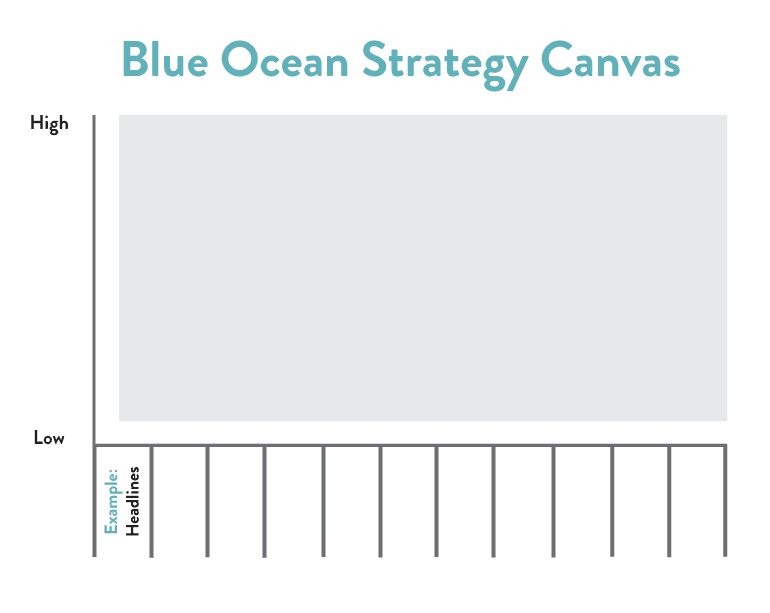Want To Make Your Blog Stand Out? Use The Blue Ocean Strategy
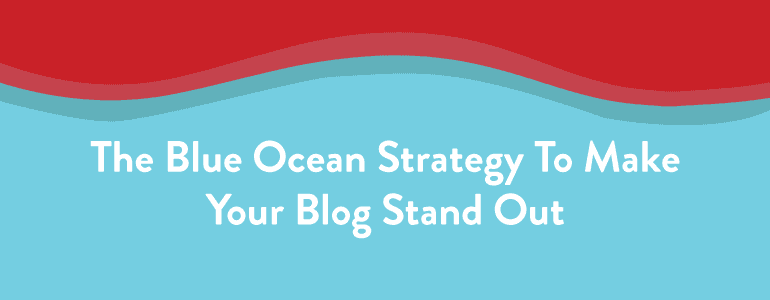 Your blog is swimming in a red sea of competition.
Your readers are over-worked, over-stimulated, and in a serious hurry. They read more than one blog on any given day, so what keeps them coming back to yours?
How do you make your blog stand out?
I've been quoted for saying that strategies are dead. I believe it, of course, but that's no excuse for not knowing how your blog stands out from the competition. For that there is nothing better than something called the 'Blue Ocean Strategy.'
Your blog is swimming in a red sea of competition.
Your readers are over-worked, over-stimulated, and in a serious hurry. They read more than one blog on any given day, so what keeps them coming back to yours?
How do you make your blog stand out?
I've been quoted for saying that strategies are dead. I believe it, of course, but that's no excuse for not knowing how your blog stands out from the competition. For that there is nothing better than something called the 'Blue Ocean Strategy.'
Red Oceans, Blue Oceans, And Your Blog
There are two types of oceans in this world, according to authors W. Chan Kim and Renee Mauborgne, the writers of the 2005 book Blue Ocean Strategy. Their book teaches readers how to create uncontested markets for reaching new customers and make their competition irrelevant. It's a great read for any business. It's also a great read for any blogger.
The first ocean that the authors describe is the red ocean of rivals. This is one of extreme competition, that has been made bloody with combative rivalries and cut-throat tactics. It is crowded, competitive, and a difficult place in which to thrive.
The second type of ocean that they describe is a blue one. The blue ocean symbolizes untapped new market spaces ripe with growth and free from competition.
In other words, blue oceans are for businesses (and blogs) that want to stand out and grow uncontested. Red oceans are for those who want to fight and scrape for attention.
Which ocean would you rather be blogging in?
It's also a great read for any blogger.
The first ocean that the authors describe is the red ocean of rivals. This is one of extreme competition, that has been made bloody with combative rivalries and cut-throat tactics. It is crowded, competitive, and a difficult place in which to thrive.
The second type of ocean that they describe is a blue one. The blue ocean symbolizes untapped new market spaces ripe with growth and free from competition.
In other words, blue oceans are for businesses (and blogs) that want to stand out and grow uncontested. Red oceans are for those who want to fight and scrape for attention.
Which ocean would you rather be blogging in?
How To Write A Blue Ocean Blog
We all want our blog to be a blue ocean blog that stands out, but what does it take to have that? The world of blogging is a competitive place. Yet oddly, we all tend to read the same articles and do a lot of the same things. We make our tactics and strategies public, so we all run the risk of falling into the 'me too' philosophy. After all, if Copyblogger does it, it has to be good. Right? RIGHT?? Here is how you can make sure that your blog is swimming the the blue oceans.#1. Avoid The Red Ocean Strategies
Choosing between the red oceans and blue oceans all comes down to the elements that your blog will compete on. The red oceans of blogging typically compete on the following things like:- Headlines – We all try to write headlines that engage readers and promote social sharing. Surely you can come up with a few "typical" blog headlines that you've seen over and over. List posts, I'm looking at you (and yes, I'm guilty as charged).
- Topic Selection – Do your topics strike an emotional cord with your audience? Many red ocean blogs cover the same topics over and over again. Sometimes this is legitimate, but many times these bloggers fail to add additional value to the conversation. Rather, they simply pile on with the same old tired information. This is a red ocean strategy.
- Shareability – How likely are your readers to share your content with others? This has quickly become the yardstick that we measure ourselves by, and if we aren't careful it can quickly become a losing proposition.
- Images – Does your content contain images that make it more 'sharable'? This is a tired line in the blogging industry that is already forcing us to think differently about how we handle images on our blog.
- Sensationalism - While I love what they've contributed to the community, sites like Upworthy have bred a sensationalism mentality in the blogging community that some might be considered dangerous.
Symptoms Of A Red Ocean Blog
- An abundance of 'me too' headlines that are more sensational than exceptional.
- A host of familiar topics that have been used time and time again.
- A meager traffic base that refuses to grow.
- Cyclical traffic that is constantly fluctuating as opposed to steady traffic that builds with time.
- You keep writing and writing, but constantly feel like you are getting nowhere.
#2. Figure Out Where Your Blue Oceans Lie
Blue oceans are very different from red ones. They symbolize an opportunity to stand out and get ahead. For a stagnant blog stuck in the red ocean of sameness, blue ocean strategies are exactly what we need to be looking for. The key is to find the blue ocean opportunities that are sitting right before you. In some cases, you may already being using some of them. If so, the trick will be doubling down on your efforts. Unlike red ocean strategies, blue ocean strategies aren't always easy to put in a list. After all, the list is against their nature of uniqueness. Besides, blue ocean strategies will be different for each blog, representing an opportunity to create differentiation within a particular audience segment or industry. Just to get you started, here are a few I came up with.Sample Blue Ocean Opportunities
- High quality content that goes beyond the requisite 500 words. On our own blog, we regularly write posts that reach 2,000 words or more.
- In-depth research that reaches beyond that typical talking points. The Buffer blog has exposed a blue ocean strategy by harnessing acumen for research and compiling data.
- Extreme openness is another blue ocean technique that Buffer uses on their Open Blog. Very few businesses reach the transparency level that Buffer openly embraces. This was a blue ocean opportunity staring them in the face.
- Design quality is also a way to make your blog stand out from the crowd. Designer Jason Santa Maria regularly designs completely unique blog posts that go well beyond the typical black on white drabness. As a designer himself, this was an obvious blue ocean for the taking. Software company Panic is also a great example of a blue ocean blog that uses design as their distinguishing factor.
- Branded guides are one of the tools that blogger Neil Patel uses to create a blue ocean for his a Quick Sprout blog. These guides combine in-depth information and design to create some of the most powerful and commanding guides online.
- What can I do, or already do, better than any other blogger?
- What makes me different?
- Why do my most loyal readers come back time and time again?
- Who is reading my blog that I wasn't respecting?
- What blog posts am I the most proud of? Why?
#3. Test Your Assumptions Using The Blue Ocean Canvas
Once you've identified a few of your blue ocean opportunities, you will need to make sure that your blue oceans are really blue oceans. Fortunately, there is a handy tool for this called the blue ocean strategy canvas. Heck, there is even an app for that! Here's what you'll need to do:1. List out two or three primary competitors in your blogging niche.
2. Choose five or six red ocean strategies that I listed above, or a few that you come up with on your own. They can vary by industry.
3. Select five or six of the blue ocean ideas that you brainstormed above.
4. List out your factors, and map them out on the blue ocean strategy canvas.
5. For each factor, plot out the offering level for both you and your competitors. How do you each rank for each factor?
If things go well....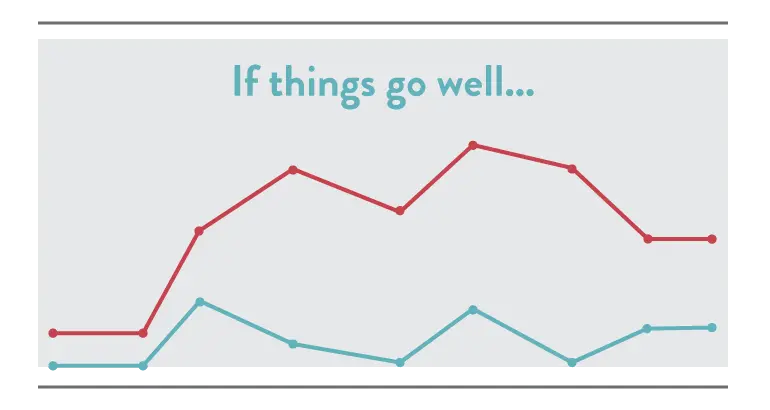 If things go as planned with your canvas, you should see a clear divergence between your red oceans and blue oceans. The blue ocean opportunities will typically be the furthest away from your competitors on the canvas. The red oceans will likely likely lineup in very close proximity to those same competitors. In all likelihood, you will have some of both. The further away your plot points are, the more attention your factor deserves. Those are the blue oceans.
If things go poorly...
If things go as planned with your canvas, you should see a clear divergence between your red oceans and blue oceans. The blue ocean opportunities will typically be the furthest away from your competitors on the canvas. The red oceans will likely likely lineup in very close proximity to those same competitors. In all likelihood, you will have some of both. The further away your plot points are, the more attention your factor deserves. Those are the blue oceans.
If things go poorly...
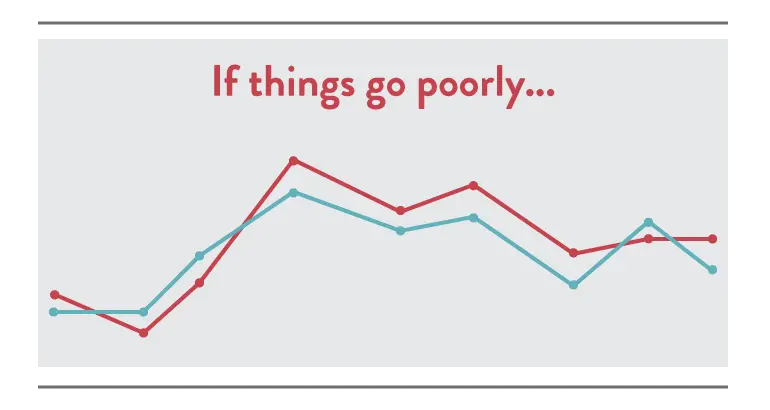 If things go poorly with your canvas, you won't have any blue oceans or at least very few to work from. This will by symbolized by almost all plot points lining up nearly on top of each other. If this is what you get, take some time to reevaluate blue ocean ideas and think again.
If things go poorly with your canvas, you won't have any blue oceans or at least very few to work from. This will by symbolized by almost all plot points lining up nearly on top of each other. If this is what you get, take some time to reevaluate blue ocean ideas and think again.
#4. Set Sail With Your Blue Ocean Strategy
The blue ocean canvas is a great way to think through and visualize your ideas, but the work doesn't stop there. Consider this document a blueprint on where to focus your efforts over the coming months. What would happen if you put twice as much energy into each of your blue ocean opportunities. What would happen to your traffic? How would it impact your desire to blog? Set sail, and let your blog stand out.What Happened When Groove Landed A Blue Ocean Opportunity?
I've mentioned help desk software provider Groove on this blog before. They deserve the praise. Along with blogs like Buffer and Panic, Groove has also discovered a blogging blue ocean. The one major difference is that they were brave enough to make the switch from a purely red ocean strategy to a blue ocean panacea. Earlier this year Groove founder Alex Turnbull released a blog post that outlined their shift from a red to a blue ocean strategy. He tells the story of their more "traditional" content marketing blog that was covering the same tired topics in the usual ways. They were swimming in a red ocean, and it was showing. Alex's message to his staff. It was time to go blue.
The team brainstormed, and launched, a completely new blogging format in just 30 days. Rather than covering the same topics that their competitors were treading on, Groove starting talking about something that no one was discussing - themselves. They began talking about their journey as a software application from $30k in revenue to their goal of $100k. They began telling a story.
Alex's message to his staff. It was time to go blue.
The team brainstormed, and launched, a completely new blogging format in just 30 days. Rather than covering the same topics that their competitors were treading on, Groove starting talking about something that no one was discussing - themselves. They began talking about their journey as a software application from $30k in revenue to their goal of $100k. They began telling a story.
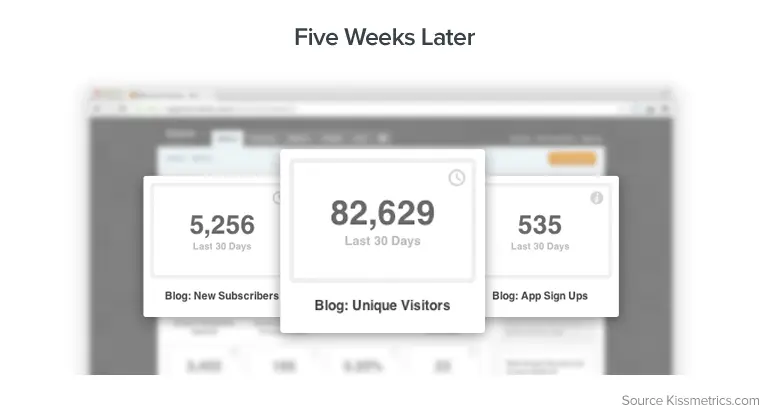 Results don't lie.
Five weeks later, they have more than eight thousand unique visitors and over five thousand new blog subscribers. They had found a blue ocean.
Results don't lie.
Five weeks later, they have more than eight thousand unique visitors and over five thousand new blog subscribers. They had found a blue ocean.
--
The thing about blue oceans is that anyone can find them. They don't have to be hard to find, or elusive. They are out there. The biggest problem is that we don't usually take the opportunity to look. As bloggers, it can be easy to make a schedule, and set a path for moving forward. We make our plans and execute them, but what are we missing? This is when we get into trouble and start falling into the tired red ocean ways. We let our blog get swallowed up by a red ocean of competition. Don't let it happen to you. Find your blue ocean, and double down on making it a reality. This is what it's going to take to truly make your blog stand out.